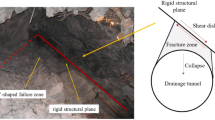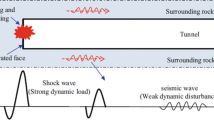Abstract
The hydraulic fracturing (HF) has been used to create new flow paths or enhance existing flow paths, thus, enabling the permeability of rocks by increasing the connected porosity of rocks. During HF, the release of energy in the form of seismic waves causes tremors and minor earthquakes. Experimental results on the performance of rocks during HF tests are shown in the form of two parts, by varying between a high and low injection rate of 20 and 2 ml/min, respectively, into the matrix of two different rock types (soft gypsum and hard granite). Part 2 attempted to simulate real-life HF events in the field. To acquire the micro-seismic events, acoustic emission sensors were attached to each lateral surface of the specimen and later processed into four source mechanisms (tensile, compressive, shear and mixed-mode). The micro-seismic activity was larger for granite subjected to higher injection rate. The source mechanisms were found to be mainly material-dependent because three distinct time intervals (stages) were identified for each material type. The location of AE events was interpreted to be material- and injection-rate-dependent. The AE events recorded in gypsum tests were spread across their surface with no apparent correlation between new cracks and fluid fronts, while for granite, they were close to the new propagated cracks and/or within the fluid fronts (compressive mechanisms were less predominant in the middle of the specimen), while there were distinct behaviors for each material subjected to different injection rates.



















Similar content being viewed by others
References
Aki, K., Richards, P.G.: Quantitative seismology, vol. II. University Science Books (2009)
Asanuma, H., Nozaki, H., Niitsuma, H., Wyborn, D.: Interpretation of microseismic events with larger magnitude collected at Cooper Basin. Australia Trans. - Geotherm Res. Counc. 29, 87–91 (2005)
Backers, T.: Fracture Toughness Determination and Micromechanics of Rock Under Mode I and Mode II Loading. University of Potsdam, Germany (2004)
Baig, E., Urbancic, T.: Microseismic moment tensors: a path to understanding frac growth. Lead Edge (2010). https://doi.org/10.1190/1.3353729
Baptista-Pereira, C., Gonçalves da Silva, B.: Diffusivity-dependent fracturing processes and microseismic activity in granite. 2nd Int. Conf. energy Geotech. E3S Web Conf., La Jolla, CA:, p. 1–6.(2020). https://doi.org/10.1051/e3sconf/202020502009.
Baptista-Pereira, C., Gonçalves da Silva, B.: Acoustic emissions and source mechanisms observed in the hydraulic fracturing of gypsum considering fluid diffusivity. 55th U.S. Rock Mech. / Geomech. Symp., Houston, Texas (2021). https://onepetro.org/ARMAUSRMS/proceedings-abstract/ARMA21/All-ARMA21/ARMA-2021-1739/468083
Baptista-Pereira C, Li B, Gonçalves da Silva B.: Time- and pressure-dependent source mechanisms in hydraulic fracturing tests in granite considering fluid diffusivity. 54th U.S. Rock Mech. Symp. Phys. event Cancel. One Petro (2020). https://onepetro.org/ARMAUSRMS/proceedings-abstract/ARMA20/All-ARMA20/ARMA-2020-1587/447639
Baria, R., Green, A.S.P., Jones, R.H.: Anomalous seismic events observed at the CSM HDR project, U.K. Int. J. Rock Mech. Min. Sci. 26, 257–69 (1989). https://doi.org/10.1016/0148-9062(89)91975-X
Bu, F., Xue, L., Zhai, M., Huang, X., Dong, J., Liang, N.: Evaluation on characterization of acoustic emission of brittle rocks from the experiment to numerical simulation. Sci. Rep. 12, 1–26 (2022)
Byerlee, JD., Lockner, D.: Acoustic emission during fluid injection into rock. 1st Conf. Acoust. Emiss. Act. Geol. Struct. Mater. (1997), p. 87–98.
Weisstein, EW.: Convolution. MathWorld-A Wolfram Web Resour n.d. https://mathworld.wolfram.com/Convolution.html (accessed November 27, 2020).
Dahm, T., Kruger, F.: Moment tensor inversion and moment tensor interpretation. ( 2014). https://doi.org/10.2312/GFZ.NMSOP-2_IS_3.9.
Deflandre, J.P.: Laboratory analysis of acoustic emission associated with the hydraulic fracturing of sandstone samples. The problem of fracture location. Oil Gas Sci. Technol. 44, 673–91 (1989). https://doi.org/10.2516/ogst:1989037
Feng, Y., Gray, K.E.: Discussion on field injectivity tests during drilling. Rock Mech. Rock Eng. 50, 493–498 (2016). https://doi.org/10.1007/s00603-016-1066-1
Frash, LP., Gutierrez, MS.: Laboratory-scale study of hydraulic fracturing in heterogeneous media for enhanced geothermal systems and general well stimulation. Colorado School of Mines (2014).
Gonçalves da Silva, B.: Fracturing processes and induced seismicity due to the HF of rocks. Massachusetts Institute of Technology, ( 2016).
Goodfellow, S.D., Nasseri, M.H.B., Maxwell, S.C., Young, R.P.: Hydraulic fracture energy budget: insights from the laboratory. Geophys. Res. Lett. 42, 3179–3187 (2015). https://doi.org/10.1002/2015GL063093
Graham, C.C., Stanchits, S., Main, I.G., Dresen, G.: Comparison of polarity and moment tensor inversion methods for source analysis of acoustic emission data. Int. J. Rock Mech. Min. Sci. 47, 161–169 (2010). https://doi.org/10.1016/j.ijrmms.2009.05.002
Grosse, CU., Ohtsu, M.: Acoustic emission testing: Basics for sesearch - applications in Civil Engineering. Springer; ( 2008). https://doi.org/10.1007/978-3-540-69972-9.
Gunarathna, GS., Gonçalves da Silva, B.: Effect of the state of stress in the fracturing and micro-seismic activity of hydraulically-fractured granite. 53rd US Rock Mech Symp (2019). https://onepetro.org/ARMAUSRMS/proceedings-abstract/ARMA19/All-ARMA19/ARMA-2019-1776/124964
Gunarathna GS. Stress-state and injection-rate dependent damage processes during the hydraulic fracturing of granite (Ph.D. Thesis). New Jersey Institute of Technology,(2020).
Gutenberg, B.: The Energy of Earthquakes. Q J Geol Soc London 1955:1–14 (1955).
Hampton, J., Gutierrez, M., Matzar, L., Hu, D., Frash, L.: Acoustic emission characterization of microcracking in laboratory-scale hydraulic fracturing tests. J. Rock Mech. Geotech. Eng. 10, 805–817 (2018). https://doi.org/10.1016/j.jrmge.2018.03.007
Hanks, T.C., Kanamori, H.: A moment magnitude scale. J. Geophys. Res. Solid Earth. 84, 2348–50 (1979). https://doi.org/10.1029/JB084iB05p02348
Hardy, JHR.: Acoustic Emission/Microseismic Activity Volume 1: Principles, Techniques and Geotechnical Applications. A.A Balkema Publishers; (2003).
Ishida, T.: Acoustic emission monitoring during hydraulic fracturing in laboratory and field. Constr. Build. Mater. 15, 283–295 (2001)
Jia, SQ., Wong, RCK., Eaton, DW.: Acoustic emission monitoring of a laboratory hydraulic fracturing experiment on Montney shale. 53rd US Rock Mech Symp (2019).
Kanamori, H., Anderson, D.: Theoretical basis of some empirical relations in seismology. Bull. Seismol. Soc. Am. 65, 1073–1095 (1975)
Kendall, J.M., Butcher, A., Stork, A.L., Verdon, J.P., Luckett, R., Baptie, B.: How big is a small earthquake? Challenges in determining microseismic magnitudes. First Break 37, 51–56 (2019). https://doi.org/10.3997/1365-2397.n0015
Knopoff, L., Randall, M.J.: The compensated linear - vector dipole: a possible mechanism for deep earthquakes. J. Geophys. Res. 75, 4957–4963 (1970)
Kranz, R.L., Satoh, T., Nishizawa, O., Kusunose, K., Takahashi, M., Masuda, K., et al.: Laboratory study of fluid pressure diffusion in rock using acoustic emissions. J. Geophys. Res. 95, 21593–21607 (1990). https://doi.org/10.1029/jb095ib13p21593
Labuz, J.F., Shah, S.P., Dowding, C.H.: The fracture process zone in granite: evidence and effect. Int. J. Rock Mech. Min. Sci. 24, 235–246 (1987). https://doi.org/10.1016/0148-9062(87)90178-1
Li, Y.P., Chen, L.Z., Wang, Y.H.: Experimental research on pre-cracked marble under compression. Int. J. Solids Struct. 42, 2505–2516 (2005). https://doi.org/10.1016/j.ijsolstr.2004.09.033
Li, B.Q., Moradian, Z., Gonçalves Da Silva, B., Germaine, J.T.: Observations of acoustic emissions in a hydraulically loaded granite specimen 49th US Rock Mech. Geomech. Symp. 2015(3), 2206–12 (2015)
Li, B.Q., Gonçalves da Silva, B., Einstein, H.: Laboratory hydraulic fracturing of granite: Acoustic emission observations and interpretation. Eng. Fract. Mech. 209, 200–20 (2019). https://doi.org/10.1016/j.engfracmech.2019.01.034
Li, QB.: Acoustic emissions in hydraulic fracturing of Barre granite (Master Thesis). Massachusetts Institute of Technology, (2015).
Lockner, D.: The role of acoustic emission in the study of rock fracture. Int. J. Rock Mech. Min. Sci. 30, 883–899 (1993). https://doi.org/10.1016/0148-9062(93)90041-B
Lockner, D., Byerlee, J.D.: Hydrofracture in weber sandstone at high confining pressure and differential stress. J. Geophys. Res. 82, 2018–2026 (1977). https://doi.org/10.1029/jb082i014p02018
Maxwell, S.: Microseismic imaging of hydraulic fracturing: improved engineering of unconventional shale reservoirs, SEG distinguished instructor, Series No. 17. (2014).
Mayr, S.I., Stanchits, S., Langenbruch, C., Dresen, G., Shapiro, S.A.: Acoustic emission induced by pore-pressure changes in sandstone samples. Geophysics (2011). https://doi.org/10.1190/1.3569579
McGarr, A., Simpson, D., Seeber, L.: 40 Case histories of induced and triggered seismicity. Int. Geophys. 81, 647–661 (2002). https://doi.org/10.1016/S0074-6142(02)80243-1
Moradian, Z.A., Ballivy, G., Rivard, P., Gravel, C., Rousseau, B.: Evaluating damage during shear tests of rock joints using acoustic emissions. Int. J. Rock Mech. Min. Sci. 47, 590–598 (2010). https://doi.org/10.1016/j.ijrmms.2010.01.004
Moradian, Z.A., Einstein, H.H., Ballivy, G.: Detection of cracking levels in brittle rocks by parametric analysis of the acoustic emission signals. Rock Mech. Rock Eng. 49, 785–800 (2016). https://doi.org/10.1007/s00603-015-0775-1
Nadimpalli, S.: Mechanics of Materials ME620 Fall2018 (2018).
Obert, L., Duvall, W.: Use of subaudible noise for the prediction of rock bursts (1942). UNT Digital Library: https://digital.library.unt.edu/ark:/67531/metadc38443/m1/1/
Obert, L.: Use of subaudible noise for the prediction of rock bursts (1941). Hathi Trust Digital Library: https://babel.hathitrust.org/cgi/pt?id=mdp.39015078475574&view=1up&seq=1
Ohtsu, M.: Acoustic emission theory for moment tensor analysis. Res. Nondestruct. Eval. 6, 169–184 (1995). https://doi.org/10.1080/09349849509409555
Ohtsu, M.: The history and development of acoustic emission in concrete engineering. Mag. Concr. Res. 48, 321–330 (1996)
Pearson, C.: The relationship between microseismicity and high pore pressures during hydraulic stimulation experiments in low permeability granitic rocks. J. Geophys. Res. 86, 7855–7864 (1981)
Li, BQ.: MIT Rock Mechanics Group AE Code (2019).
Rutledge, J.T., Phillips, W.S.: Hydraulic stimulation of natural fractures as revealed by induced microearthquakes, Carthage Cotton Valley gas field, east Texas. Geophysics 68, 441–452 (2003). https://doi.org/10.1190/1.1567214
Savic, M., Cockram, M.J., Ziolkowski, A.M.: Active ultrasonic monitoring of laboratory-scale hydraulic fracturing experiments: numerical modelling versus experiment. Offshore Eur. 93, 419–28 (1993). https://doi.org/10.2523/26793-ms
Sayers, C.M.: Fluid flow in a porous medium containing partially closed fractures. Transp. Porous. Media 6, 331–336 (1991). https://doi.org/10.1007/BF00208956
Shearer, PM.: Introduction to seismology: Second Edition. vol. 33. ( 2009).
Staněk, F., Eisner, L.: Seismicity induced by hydraulic fracturing in shales: a bedding plane slip model. J. Geophys. Res. Solid. Earth. 122, 7912–7926 (2017). https://doi.org/10.1002/2017JB014213
Stover, C., Green’s Function.: MathWorld--A Wolfram Web Resour Creat by Eric W Weisstein n.d. https://mathworld.wolfram.com/GreensFunction.html (accessed November 27, 2020).
Vavryčuk, V.: Moment tensor decompositions revisited. J. Seismol. 19, 231–252 (2015). https://doi.org/10.1007/s10950-014-9463-y
Zang, A., Wagner, F.C., Stanchits, S., Dresen, G., Andresen, R., Haidekker, M.A.: Source analysis of acoustic emissions in Aue granite cores under symmetric and asymmetric compressive loads. Geophys. J. Int. 135, 1113–1130 (1998). https://doi.org/10.1046/j.1365-246X.1998.00706.x
Zhang, H., Eaton, D.W., Li, G., Liu, Y., Harrington, R.M.: Discriminating induced seismicity from natural earthquakes using moment tensors and source spectra. J. Geophys. Res. Solid Earth. (2016). https://doi.org/10.1002/2015JB012603
Zietlow, W.K., Labuz, J.F.: Measurement of the intrinsic process zone in rock using acoustic emission. Int. J. Rock Mech. Min. Sci. 35, 291–299 (1998). https://doi.org/10.1016/S0148-9062(97)00323-9
Zimmerman, R.W., Bodvarsson, G.S., S, B.G.: Hydraulic conductivity of rock fractures. Transp. Porous. Media. 23, 1–30 (1996)
Zoback, M.D., Rummel, F., Jung, R., Raleigh, C.B.: Laboratory hydraulic fracturing experiments in intact and pre-fractured rock. Int. J. Rock Mech. Min. Sci. 14, 49–58 (1977). https://doi.org/10.1016/0148-9062(77)90196-6
Acknowledgements
Dr. Gonçalves da Silva contributed largely to this paper, not only by being an exceptional mentor, but also by transmitting his knowledge to the scientific community. Thus, the authors would like to express their deeply appreciation. Moreover, the authors of this paper would like to express their sincere gratitude to the United States National Science Foundation (Award Number 1738081 and program manager Dr. Richard Fragaszy). Finally, the authors also acknowledge four students who have contributed to the development of this project: Josué Deidan-Alvarado and Edisberto Cardona Jr., former NJIT undergraduate students; Jas Ahuja, current NJIT undergraduate student; and Christopher Park, a former high-school student.
Funding
National Science Foundation, 1738081, Bruno Gonçalves da Silva.
Author information
Authors and Affiliations
Corresponding author
Ethics declarations
Conflict of interests
The authors have not disclosed any competing interests.
Additional information
Publisher's Note
Springer Nature remains neutral with regard to jurisdictional claims in published maps and institutional affiliations.
Supplementary Information
Below is the link to the electronic supplementary material.
Rights and permissions
About this article
Cite this article
Baptista-Pereira, C., Gonçalves da Silva, B. & Meegoda, J.N. Hydraulic Fracturing of Soft and Hard Rocks. Part 2: Acoustic Emissions, Source Mechanisms and Energy. Transp Porous Med 144, 587–622 (2022). https://doi.org/10.1007/s11242-022-01819-y
Received:
Accepted:
Published:
Issue Date:
DOI: https://doi.org/10.1007/s11242-022-01819-y




